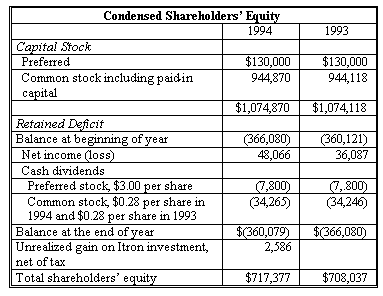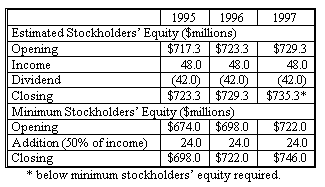- CFA Exams
- 2023 Level I > Topic 3. Financial Statement Analysis
- 4. Debt Covenants
Seeing is believing!
Before you order, simply sign up for a free user account and in seconds you'll be experiencing the best in CFA exam preparation.
Subject 4. Debt Covenants
Bond covenants are a bond issuer's enforceable promises to perform or refrain from performing certain actions.



1997: Increase = 2 x shortfall in equity = 2 x (746.0 - 735.3) = 21.4 million 1998: Income must equal $84 million, twice the dividend, to maintain equity at the required level.
- Affirmative covenants set forth certain actions that issuers must take, such as:
- paying interest and principal on a timely basis.
- paying taxes and other claims when due.
- keeping assets in good conditions and in working order.
- submitting periodic reports to a trustee so the trustee can evaluate the issuer's compliance with the indenture.
- Negative covenants set forth certain limitations and restrictions on the borrower's activities, such as limitations on:
- the borrower's ability to incur additional debt or other liabilities.
- dividend payments and stock repurchases.
- production and investment (mergers and acquisitions, sales and leaseback, or outright disposal of certain assets).
- payoff patterns (sinking fund requirements and the priorities of claims on assets).
In addition to direct restrictions on activities, covenants may require maintenance of certain levels of such accounting-based financial variables as stockholders' equity (or retained earnings), working capital, interest coverage, and debt-to-equity ratios.
Auditors and management must certify that the firm has not violated the covenants. If any covenant is violated, the firm is in technical default of its leading agreement, and the creditor can demand repayment of the debt after the stated grace period.
Example
The following exhibit contains information from NorAm Energy's 1994 Annual Report regarding debt covenants imposed by its creditors. The covenants restrict borrowings and dividend payments.

Note 5: Restrictions on Stockholders' Equity and Debt:
Under the provision of the Company's revolving credit facility as described in Note 3, and under similar provisions in certain of the Company's other financial arrangements, the Company's total debt capacity is limited and it is required to maintain a minimum level of stockholders' equity.
- The required minimum level of stockholders' equity was initially set at $650 million at December 31, 1993, increasing annually thereafter by (1) 50% of positive consolidated net income and (2) 50% of the proceeds (in excess of the first $50 million) of any incremental equity offering made after June 30, 1994.
- The Company's total debt is limited to $2,055 million.
Based on these restrictions, the Company has incremental debt issuance and dividend capacity of $321.2 million and $43.3 million, respectively, on December 31, 1994. The Company's revolving credit facility also contains a provision that limits the Company's ability to reacquire, retire, or otherwise prepay its long-term debt prior to its maturity, to a total of $100 million.
The exhibit states that as of December 31, 1994 the company has a dividend capacity equal to $43.3 million. This amount was computed after reflecting the annual dividend of $42 million declared in 1994.
Question 1. How was the figure $43.3 million computed?

Question 2. State whether the debt covenants restrict NorAm's ability to maintain its annual dividend through 1998. Justify your answer by preparing a schedule for the years 1995 - 1998 showing NorAm's expected and minimum shareholders' equity given current income and dividend levels.
Without any increase in income, the current dividend can be maintained for only two years:

As the table above shows, in 1997 the minimum equity requirement will be violated.
Question 3. Compare the level of income that would be required to maintain current dividend levels through 1998.
To maintain dividend payments at the 1994 level through 1998, income would have to increase. The required income for 1997 and 1998 is $69.4 million and $84 million respectively. These amounts result in the following table for those years:

These amounts can be calculated as follows:
1997: Increase = 2 x shortfall in equity = 2 x (746.0 - 735.3) = 21.4 million 1998: Income must equal $84 million, twice the dividend, to maintain equity at the required level.
Question 4. In 1995, NorAm approached its shareholders with a proposal to issue new shares. What are possible reasons the company was motivated to make this proposal? Would you, as a shareholder, have supported the proposal?
The answer would depend on the shareholder' view of the market price of NorAm's shares. Issuance of new shares to maintain the current dividend makes no sense given finance theory, which states that the two are equivalent. In an imperfect market, however, NorAm's shares may have been fully valued but the shareholder may not have wished to sell and incur capital gains taxes. If NorAm had attractive investment opportunities not reflected in its stock price, issuing new shares to increase the firm's borrowing capacity would be desirable.
Practice Question 1
Which one of the following statements regarding debt covenants is false?A. The term "technical default" is used to describe a situation where the debtor has violated one or more covenants in a loan agreement but continues to make all payments on a timely basis.
B. Negative covenants (e.g., you are not permitted to pay out annual dividends in excess of 30% of net earnings) tend to play a less significant role in loan agreements than do affirmative covenants.
C. A creditor (lender) would prefer a higher fixed charge coverage ratio to a lower value.
D. Maintaining adequate insurance on assets serving as collateral in loan agreements is an example of an affirmative covenant.Correct Answer: B
This statement is false. Negative covenants place direct restrictions on management actions and thus play a more significant role than affirmative covenants in loan agreements.
Practice Question 2
Which of the following would be classified as a financial covenant?A. Do not violate the lender's restriction on dividend payments.
B. Provide audited financial statements on a timely basis.
C. Use the loan for the agreed-upon purpose.
D. Maintain a satisfactory working capital ratio (or current ratio).Correct Answer: D
This ratio is an example of a financial test. If the debtor's working capital ratio falls below the minimal specified amount, the loan agreement may be subject to termination or modification. It is also an affirmative covenant, since it requires the borrower to take a certain action.
Practice Question 3
Which of the following would not be considered an example of a typical negative covenant of a loan document?A. The firm may not merge with another firm.
B. The firm may not pledge its assets with another lender.
C. There are limitations on the amount of dividends the firm may pay.
D. The firm may not sell or lease its major assets without prior approval by the lender.
E. The firm must furnish periodic financial statements to the lender.Correct Answer: E
Practice Question 4
Which of the following is most likely a benefit of debt covenants for the borrower?A. Reduction in the cost of borrowing
B. Limitations on the company's ability to pay dividends
C. Restrictions on how the borrowed money may be investedCorrect Answer: A
The reduction in the cost of borrowing is a benefit of covenants to the borrower.
Practice Question 5
A firm intends to take on a significant amount of new debt in order to fund the purchase of a close competitor. However, the firm cannot complete the transaction unless it first calls one of its outstanding bond issues. It must be true that the called bonds ______A. have a higher interest rate than the new bonds will.
B. can be called at a price that is very near par.
C. have covenants which restrict such increase in debt.Correct Answer: C
null
Practice Question 6
Which of the following is not an example of an affirmative (positive) covenant?A. Requirement to furnish bondholders with a copy of the firm's annual account records
B. Requirement to maintain a minimum level of net worth and a minimum level of working capital
C. Requirement to limit dividends to net incomeCorrect Answer: C
null
Practice Question 7
Bond covenants ______I. are contract provisions to protect bond investors.
II. may limit dividends or restrict new debt or acquisitions.
III. may require the maintenance of certain financial ratios.
IV. can lead to technical default if provisions are violated.
A. I, II and III
B. II, III and IV
C. All of the aboveCorrect Answer: C
null
Practice Question 8
All of the following statements about accounting practices are true EXCEPT:A. violation of a long-term debt covenant will cause the debt to be classified as short-term debt if the condition is not reversed before the end of the accounting period.
B. debt is considered to be extinguished if the firm places risk-free assets in an irrevocable trust solely for extinguishing that debt.
C. commitments under unconditional purchase obligations that provide financing to suppliers need not be recognized on the purchaser's balance sheet.Correct Answer: A
null

Study notes from a previous year's CFA exam:
4. Debt Covenants